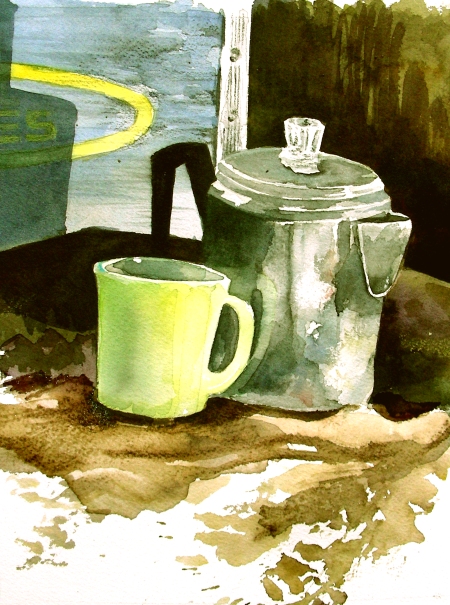
My First Watercolor, Art II Assignment
I would give anything to return to the studio today and take up the next painting–I already have a still life assembled and waiting for me. But alas, my job–progress grades are due soon and I have devoted this entire day to teaching, grading, and inputting grades for six classes covering four different subjects (ugh). I also have a scheduled meeting to attend, and business commitments later in the day. And then there are the preparations for tomorrow’s classes, and a major Academic Decathlon responsibility that I have for Saturday. I am not sure when I will get to return to the studio. Not today, and perhaps not tomorrow either. The way things look now, I may not even see the inside of my Man Cave until late Saturday. I’ll be ready.
Meanwhile, I don’t want to stop blogging. So I pause today to give thanks to an art teacher who made a difference in my life from the time of my sophomore year in high school. Leo Hoeh was an articulate man, with a vocabulary that challenged my mental laziness (I had almost zero interest in intellectual exploration throughout my high school years). What caught my attention was Mr. Hoeh’s facility in handling the watercolor medium. He taught us to soak and stretch watercolor paper over canvas stretchers, using a staple gun. I thought this was normal until my university years and the years following, when many people expressed their surprise at my working on stretched watercolor paper. I cannot thank Mr. Hoeh enough for demonstrating that method of preparation. When I use paper lighter than 300-lb., I prefer it stretched. It dries so much more quickly than the watercolor block, and I love the spring that I feel on the surface when I am drawing, or working vigorously with the brush, or scrubbing it. There is a dynamic there that cannot be described. I just love it.
I still recall my fascination when watching Mr. Hoeh demonstrate before the class. He made it look so easy, working wet-on-wet, the colors billowing about in the puddles of wash. And he could do the most amazing things with India ink on the moistened paper (I never could, and still cannot). He encouraged us to welcome accidents, to learn to accommodate them, to be flexible while going through the process of wet-on-wet watercoloring. I struggled with the medium, failing again and again, but the patience of this teacher was boundless. He never seemed displeased or concerned. He just gently prodded me on, urging me to stay with it, to believe in it, and above all, to keep the sketchbook growing with new ideas. He was the first art teacher to show interest in my sketches of the farm where my grandparents resided, and he especially focused on my grandfather’s old dwelling, that I have painted repeatedly throughout my career.
The photo posted above began as a 35mm print, then was later copied onto a 35mm slide, and then later scanned and Photoshopped. This is about the best I can do in restoring the image of a painting done in 1970 when I was in Art II. Mr. Hoeh had set up an arrangement of papier-mache flowers on wire stems, sticking out of a brick. I was scared to death of the composition, drawing the petals of the flowers, re-drawing, and re-drawing some more, afraid to approach them with watercolor. I found the Prang set of pigments very unforgiving (like Andrew Wyeth, I found the green totally repugnant), and I had no idea how to model the petals in color. Finally, I surprised myself when I laid down a pure pigment on the dry paper, wet the brush, and then dragged the color to the side, watching it gradually pale. One petal was all it took. Then I was hooked. I got it. And yes, this painting was totally controlled, totally lacking in spontaneity, but it thrilled me to see that I could transition from the rich intensity of a color to its gradual paleness, and finally to white, with no sudden shifts or creases. The longer I worked on this, the more I hated to see it draw to a conclusion.
Mr. Hoeh entered a number of our works into a local exhibition/competition at Jefferson County Junior College. One evening I received a phone call from the Chairman of the Art Department, notifying me that I had placed third, would be awarded a ribbon and a $10 check. I was only in the tenth grade, and I was overwhelmed. When my parents took me to the reception, we were greeted by Mr. Hoeh in the lobby, who smilingly pointed to a wire sculpture of a mosquito dangling from the ceiling with the first place ribbon hanging from its feet. “That was what beat all of us,” he smilingly said. We just rolled our eyes.
Thank you, Mr. Hoeh, for believing in me, and giving me the confidence that I could “solve” watercolor. I wish I had told you this much earlier in life.
And thanks to the rest of you for reading.

High School Yearbook Photo from 1970











